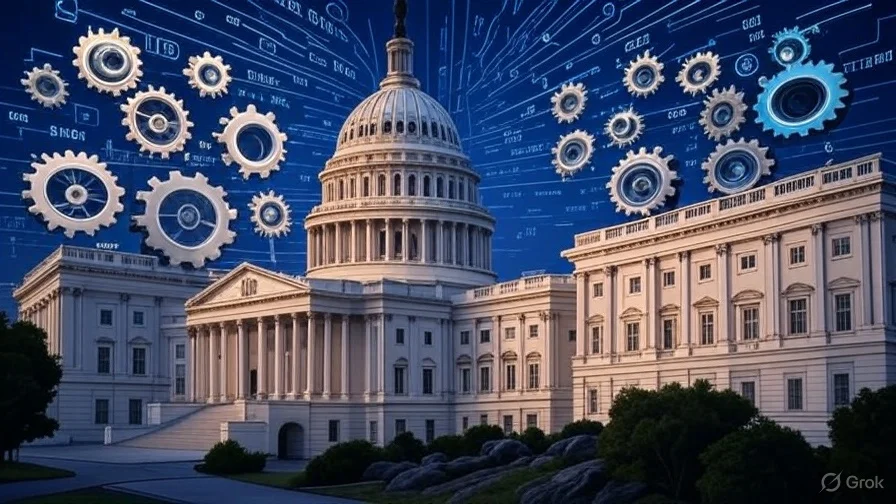The world of consumer product safety is undergoing a significant transformation, with lawmakers actively seeking to equip regulatory bodies with the advanced capabilities of artificial intelligence. This proactive approach aims to bolster consumer protection in an era where technology evolves at an unprecedented pace. The recent introduction of the bipartisan Consumer Safety Technology Act in the Senate, mirroring legislation already passed by the House, underscores this commitment. This groundbreaking bill is poised to revolutionize how agencies like the Consumer Product Safety Commission (CPSC) operate, leveraging AI to proactively identify and mitigate risks associated with everyday products.
The core of this legislative push is to grant consumer product regulators enhanced tools, specifically Artificial Intelligence, to proactively safeguard the public. This is not merely an incremental update; it represents a fundamental shift towards a more technologically adept and data-driven approach to consumer safety. The urgency is clear: as bad actors increasingly employ sophisticated AI tools for illicit purposes, the agencies tasked with protecting consumers must be equally, if not more, advanced. This initiative seeks to level the playing field, ensuring that regulatory bodies possess the necessary technological prowess to stay ahead of emerging threats and ensure that the products consumers interact with daily meet stringent safety standards. The implications are far-reaching, promising a future where product safety is more robust, responsive, and ultimately, more effective.
Empowering Regulators with Artificial Intelligence for Enhanced Consumer Safety
The imperative to equip consumer product regulators with cutting-edge artificial intelligence tools has gained significant momentum in legislative circles. The introduction of the Consumer Safety Technology Act is a pivotal moment, signaling a clear intention to integrate advanced AI into the fabric of consumer protection. This legislation empowers agencies like the Consumer Product Safety Commission (CPSC) to establish pilot programs that harness AI’s analytical power. The primary objective of these programs is to meticulously track product injury trends, proactively identify potential hazards lurking within consumer goods, monitor and manage product recalls with greater efficiency, and pinpoint specific products that fail to meet critical safety standards.
The vision is to move beyond reactive measures to a more predictive and preventative model of consumer safety. AI’s capacity to process vast datasets, identify subtle patterns, and forecast potential risks offers an unparalleled advantage. By analyzing historical injury data, consumer feedback, and product defect reports, AI algorithms can flag emerging dangers long before they become widespread problems. This proactive stance is crucial in a market flooded with an ever-increasing array of consumer products, from smart home devices to children’s toys. The ability to anticipate and address potential issues at an early stage will undoubtedly lead to fewer injuries, fewer recalls, and a greater sense of security for consumers. This legislative initiative is a testament to the understanding that in the digital age, robust consumer protection must evolve in tandem with technological advancements.

Proactive Hazard Identification and Trend Analysis
One of the most significant contributions of AI to consumer product safety lies in its ability to perform sophisticated hazard identification and trend analysis. Traditional methods of monitoring product safety often rely on manual data collection and analysis, which can be time-consuming and prone to missing subtle yet critical signals. Artificial intelligence, on the other hand, can sift through massive volumes of data – including consumer complaints, social media discussions, medical reports, and warranty claims – at an unprecedented speed and scale.
By employing machine learning algorithms, AI can identify recurring patterns and anomalies that might indicate a growing safety concern. For instance, AI could detect a sudden surge in reports of a specific type of injury associated with a particular product category, even if individual reports might seem isolated. This allows regulators to intervene swiftly, investigate the root cause, and potentially prevent widespread harm. Furthermore, AI can analyze product design specifications and manufacturing data to identify potential vulnerabilities before products even reach the market. This predictive capability shifts the focus from responding to injuries to preventing them altogether, creating a safer marketplace for everyone. The integration of AI into this domain promises a paradigm shift in how potential dangers are discovered and addressed, moving towards a truly proactive safety ecosystem.
Streamlining Recall Processes and Enhancing Enforcement
Product recalls, while essential, can be complex and challenging to manage effectively. AI offers the potential to significantly streamline these processes, making them more efficient and impactful. By analyzing data on product distribution, sales figures, and consumer demographics, AI can help identify the most at-risk populations and regions, allowing for more targeted and effective recall notifications. This ensures that consumers who have purchased potentially dangerous products are informed quickly and directly.
Beyond recalls, AI can bolster enforcement efforts by identifying manufacturers or products that consistently fall short of safety standards. AI-powered systems can monitor compliance across a wide range of products and companies, flagging potential violations for further investigation. This targeted approach allows regulatory bodies to focus their limited resources on the areas of greatest concern, ensuring that manufacturers are held accountable for upholding safety regulations. The ability of AI to continuously monitor and analyze vast amounts of data provides an unparalleled level of oversight, strengthening the overall enforcement framework and fostering a culture of compliance within the industry. This enhanced efficiency and focused enforcement will ultimately translate to fewer unsafe products on the market and greater protection for consumers.

Exploring Blockchain and Digital Tokens for Enhanced Security and Transparency
Beyond the direct application of AI to product safety, the Consumer Safety Technology Act also directs the Federal Trade Commission (FTC) and the Commerce secretary to investigate the potential of blockchain technology and digital tokens. This forward-thinking provision recognizes that advancements in digital technologies can have a profound impact on consumer protection across various sectors.
Blockchain technology, with its inherent characteristics of transparency, immutability, and distributed ledger, holds significant promise for strengthening supply chain integrity. By creating tamper-proof records of a product’s journey from manufacturing to the consumer, blockchain can help verify authenticity, track components, and identify counterfeit goods more effectively. This can be particularly crucial for high-risk products where provenance and quality control are paramount.
Furthermore, the legislation’s focus on digital tokens acknowledges the evolving landscape of financial transactions and the potential for new avenues of fraud. By examining how these technologies can be leveraged to protect consumers against fraudulent activities and deceptive practices, policymakers are looking to ensure that regulatory frameworks adapt to emerging financial innovations. The goal is to foster an environment where responsible innovation can thrive without creating new vulnerabilities for consumers. This dual focus on AI and blockchain signifies a comprehensive approach to modernizing consumer protection in an increasingly digital and interconnected world.
The Legislative Push: A Bipartisan Commitment to Consumer Safety
The bipartisan nature of the Consumer Safety Technology Act is a strong indicator of the widespread recognition among policymakers that adapting to new technologies is essential for effective consumer protection. The Senate bill, championed by Senators John Curtis (R-Utah) and Lisa Blunt Rochester (D-Del.), represents a united front in addressing the evolving challenges of the modern marketplace. This collaboration underscores the understanding that consumer safety is not a partisan issue but a fundamental necessity that requires innovative solutions.
The companion bill’s passage in the House of Representatives, introduced by Representative Darren Soto (D-Florida), further solidifies this legislative momentum. Representative Soto’s earlier assertion that the legislation would “help make the CPSC more efficient” and his acknowledgment that “the crooks are already using AI” highlight the urgency driving these efforts. The sentiment is clear: if malicious actors are leveraging advanced technologies for nefarious purposes, then law enforcement and regulatory bodies must be empowered with similar tools to counter these threats effectively. This legislative push is not about stifling innovation but about ensuring that innovation serves the public good and does not become a tool for exploitation. The commitment to modernizing regulatory frameworks reflects a proactive stance, aiming to build a more secure and trustworthy marketplace for all.
Collaboration and Stakeholder Engagement
A crucial element of the Senate bill’s approach is its emphasis on collaboration and broad stakeholder engagement. The legislation directs the CPSC to actively seek input from a diverse array of experts and industry representatives when developing its AI pilot program. This includes consulting with cybersecurity experts, technologists, data scientists, machine-learning specialists, retailers, consumer product safety advocacy groups, and manufacturers.
This inclusive approach is vital for several reasons. Firstly, it ensures that the AI tools developed are practical, effective, and aligned with the realities of the marketplace. By engaging with those who design, produce, and sell products, as well as those who represent consumer interests, the CPSC can gain invaluable insights into potential challenges and opportunities. Secondly, it fosters a sense of shared responsibility for consumer safety. When various stakeholders are involved in the development and implementation of new safety measures, there is a greater likelihood of buy-in and successful adoption. This collaborative framework aims to build a robust and adaptable system for consumer product safety, one that benefits from the collective wisdom and expertise of the entire ecosystem.
Reporting and Accountability
The legislation also establishes clear reporting mechanisms and accountability measures to ensure the effectiveness of the AI pilot program. Within a year of the pilot’s conclusion, the CPSC is mandated to submit a comprehensive report to Congress. This report will detail the findings of the AI pilot, including the data collected and, crucially, an assessment of how the use of artificial intelligence improved the Commission’s ability to advance its consumer product safety mission.
This accountability framework is essential for demonstrating the value of AI integration and for informing future policy decisions. By requiring a thorough evaluation of the program’s impact, Congress can ascertain the efficacy of the implemented AI tools and determine the potential for broader application. This systematic approach to assessing technological advancements within regulatory bodies ensures that resources are allocated effectively and that policies are evidence-based. It also provides a clear pathway for continuous improvement, allowing for adjustments and enhancements to AI strategies as new insights emerge and technologies evolve. This commitment to measurable outcomes and transparency reinforces the dedication to building a more effective and responsive consumer safety apparatus.
The Future of Consumer Safety: AI as a Cornerstone
The ongoing legislative efforts to arm consumer product regulators with AI tools represent a significant leap forward in safeguarding public well-being. The integration of artificial intelligence into regulatory processes is not merely an upgrade; it is a fundamental redefinition of how we approach consumer product safety. By embracing AI, agencies can move from a reactive stance to a proactive, predictive, and preventative model, identifying potential hazards before they manifest as injuries.
The exploration of blockchain and digital tokens further demonstrates a holistic understanding of the technological landscape and its implications for consumer protection. This forward-thinking legislation acknowledges that the future of consumer safety lies in harnessing the power of emerging technologies to create a more secure, transparent, and responsive marketplace. As AI continues to evolve, its role in ensuring that the products we use every day are safe and reliable will only grow. This initiative sets a crucial precedent, signaling a commitment to staying ahead of the curve and ensuring that consumer safety remains a top priority in an era of rapid technological advancement. The proactive adoption of these advanced tools will undoubtedly lead to a safer environment for consumers and foster greater trust in the products that shape our daily lives. The journey towards a more technologically empowered consumer safety framework has begun, and its promise is immense.




One thought on “Arming Consumer Regulators: How AI is Revolutionizing Product Safety”